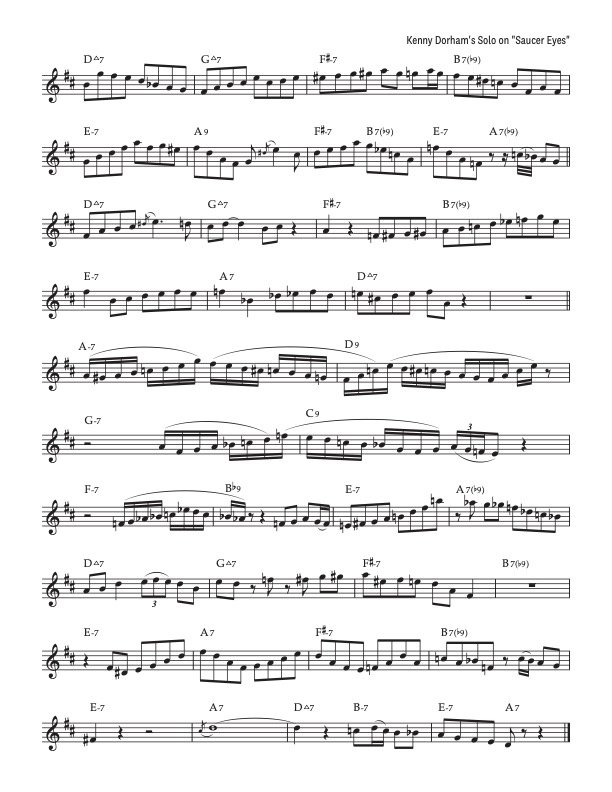Kenny Dorham - Saucer Eyes (1956)
The tune Saucer Eyes is a tune you’ll often hear called in NYC at places like the 11th St. Bar; off-the-beaten-path backrooms or underground haunts where seasoned musicians gather to play tunes from the furthest expanses of their vast tune repertoires for small, but eager crowds. The first time I heard this live was when NYC stalwart drummer Joe Farnsworth called it at Smalls Jazz Club on a new band he was fronting with master trumpeter Joe Magnarelli. This no-name band included very young musicians beginning their first semesters at Juilliard (where both Joe’s taught at the time). The premise was “young musicians playing with masters” or something to that effect.
The young cats didn’t know the tune, but the Joe’s did, of course, so they went ahead and played it while the young cats tried to hear their way through it.
There is something about this tune that is so pleasing - whether it be the catchy “hook” nature of the last 4 bars of the A sections or the 2 bar tag in the last A. Either way, musicians and listeners alike love this Randy Weston composition. For this reason, I am including the leadsheet below for you and your bands to play as you wish.
Patterns of Jazz, recorded in 1956 for Savoy
Blue Mitchell - Top Shelf (1959)
Top Shelf, composed by Jimmy Heath, is the fifth track on Blue Mitchell’s 1959 recording Blue Soul. Mitchell had two Riverside releases in 1959 - the other was recorded earlier in the year and titled Out of The Blue. Both records featured great bands (Out of The Blue has Art Blakey, Paul Chambers, Sam Jones, Cedar Walton, and Benny Golson amongst others) interpreting classic Hard Bop material arranged by Heath and Benny Golson.
Mitchell was just starting his career as a leader at this point, which makes his playing on Blue Soul rather remarkable. He represents himself as a seasoned pro; not as someone with only one major recording under their belt. If he was intimidated by his sidemen, you definitely can’t hear it.
Original album cover - Riverside Records
I’ve made a list of several interesting (to me) aspects of his solo below.
Blue played with a bright, “wide” sound to my ears. Most of this can be chalked up to his equipment choice - an Al Cass 1-28 mouthpiece and a lightweight Conn Trumpet.
Blue plays mostly diatonically to the key of F, with many enclosures. The chromaticism he uses (examples are mm. 47, 56, 67, 75, etc.) outline V-I chord movements. Modern day jazz education has coined this sound the “Bebop Scale”.
The idea that he plays in mm. 61 and 62 is something I’ve heard him play many times on other recordings.
Below is a transcription of the melody, aspects of Jimmy Heath’s original arrangement, and Blue Mitchell’s solo. Click this link to hear the original recording.
Kenny Dorham - Maxology (1951)
Maxology is a Bebop tune from a session recorded in Paris, originally released in 1951 by Prestige as “Modern Jazz Trumpets”. It features Miles Davis, Dizzy Gillespie, Fats Navarro and Kenny Dorham (also featured are James Moody, Al Haig, Tommy Potter and Max Roach). This studio session occurred during the Festival International De Jazz All Stars, which took place May 15th, 1949. Several of the tunes recorded that day were later released on other Prestige albums (Al Haig Trio and Quintet, Just Moody, etc.).
Original album cover - Prestige Records
Dizzy and KD are both in fine form on this cut. It’s obvious that KD was spending a lot of time listening to Bird, given the content of his improvisations (he was in Bird’s band at this point, of course). Dizzy’s rhythmic complexity is particularly stunning on this take, as can be seen on what he plays on the “B” sections.
I’d like to think Dizzy and KD were particularly friendly during this session. Dizzy was a mentor of sorts to KD (Dizzy had hired KD to play in his Big Band in 1946), and they must have been having great times living the lives of jazz stars in France.
Below is transcription of the melody, and solos/trading by KD and Dizzy. Click this link to hear the original recording.
Leroy Jones - Next Door Blues (1999)
In my opinion, Leroy Jones is one of the greatest trumpet players alive. Imagine someone that can combine the sensibilities of Louis Armstrong and Clifford Brown - this is where Leroy lives. Simply put, he is an amazing musician/entertainer and my absolute favorite trumpet player.
I was first introduced to Leroy’s playing in High School via Harry Connick Jr’s Big Band records. If you aren’t familiar with Blue Light, Red Light (Sony - 1991), Come By Me (Sony - 1999) and Songs I Heard (Columbia - 2001), do yourself a favor and check them out. The writing, singing and playing are amazing. These records definitely inspired me as a young person.
As a know-nothing High School Trumpet player back in the late 90’s, the first thing that struck me about his playing was his tone. He has developed a tone that literally no one in the world has. It’s round, even, resonant, powerful, delicate, sweet, beautiful - all the good adjectives. This tone, paired with his dazzling technique, allow him to enjoy a freedom of expression that few in the world get to enjoy.
His music is pure joy!
Original album cover - Sony Records
Leroy has played on many of Harry Connick Jr’s albums, but also has many fantastic recordings as a leader. I recommend Mo’ Cream From The Crop (1994 - Sony) and Props for Pops (1996 - Columbia). At some point, I’ll post his solo on Louis Armstrong’s Struttin with Some BBQ, found on Props for Pops.

















